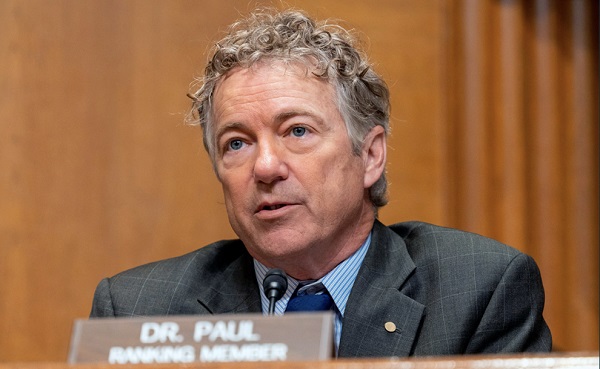Business
Report: Federal agencies spent millions of taxpayer money torturing cats

U.S. Sen. Rand Paul, R-Kentucky
From The Center Square
By
A new report published by U.S. Sen. Rand Paul, R-KY, highlights more than $1 trillion worth of taxpayer money spent on projects that he argues wastes and abuses taxpayer money.
Tucked in the report are three programs funded by federal agencies using millions of taxpayer dollars to experiment on cats.
The details are explicit and gruesome.
$11 million on Department of Defense “Orwellian cat experiments”
The US Department of Defense spent nearly $11 million on “Orwellian cat experiments” that have nothing to do with training the U.S. military or national defense.
“When George Orwell wrote 1984, he couldn’t have imagined the bizarre, dystopian reality we find ourselves in today where tax dollars are being spent to shock cats into having erections and defecating marbles. Yes, you read that correctly,” the report states.
Through the DOD’s, Defense Advanced Research Projects Agency (DARPA), $10,851,439 of taxpayer dollars were allocated to the University of Pittsburgh to conduct “grotesque and extremely invasive experiments on cats.”
This involved slicing open the backs of male cats to expose their spinal cords and inserting electrodes to send electric shocks “to make cats have an erection.”
The cats were then subjected to “even more electric shocks, sometimes for up to 10 minutes at a time, before having their spinal cords severed to paralyze their lower bodies,” the report states. “And just for good measure, the shocks continued for another 10 minutes. All this, in the name of ‘science.’”
In another DARPA-funded experiment, balloons were inserted into the cats’ colons and marbles into their rectums “to force these poor animals to defecate the marbles via electric shock.”
“Nothing says ‘national defense’ quite like torturing cats to poop marbles,” the report notes. “If we can’t stop the government from shocking cats into defecating marbles, then what can we stop?”
$2.24 million on feline COVID experiments
The report also notes that under the direction of Dr. Anthony Fauci, since 2022, the National Institute of Allergy and Infectious Diseases and the U.S. Department of Agriculture allocated $2.24 million in grants to Cornell University to conduct feline COVID experiments.
Through a University of Illinois NIAID subgrant, Cornell received $1.59 million over the past two years in addition to a $650,000 USDA grant, bringing the total to $2.24 million, the report notes.
The experiments led to the suffering and death of 30 cats, according to the records of the experiments, the report notes.
The experiments involved injecting healthy cats with COVID-19, observing them suffer and then killing them in groups of four. The cats were not given any type of vaccine or treatment but killed as early as two days after being injected and left isolated in cages.
NIAID funding for the program is slated to continue through 2025; the USDA’s through May 2026, the report notes.
“It’s a mystery as to why the U.S. government continues to fund these barbaric types of studies, especially when the knowledge gained is either useless to society or could be learned without torturing an animal,” the report states.
$1.5 million to torture primarily female kittens
The National Institutes of Health spent more than $1.5 million to torture primarily female kittens in an extreme example “of waste and cruelty,” the report found.
“If you learned that your money is being used to electro-shock young kittens, torturing them for hours on end, and to the point that they vomit, would you believe it?” the report asks. “Since 2019, $1,513,299 worth of taxpayer money has been going to these medieval-type experiments. This is not some distant, dystopian future; it’s happening right now at the University of Pittsburgh, courtesy of a grant from the NIH.”
According to the report, primarily female kittens between four and six months old were strapped to a hydraulic table, spun 360 degrees, flashed with bright lights, injected with copper sulfate, had holes drilled into their skulls, to be “shocked, and abused without resistance.”
According to NIH, the purpose of the experiments is to study how different species, like cats and monkeys, respond to motion sickness. Understanding responses to the test “could have implications for human health, potentially aiding in the treatment of conditions like vertigo or helping us understand the effects of space travel on the human body,” the report states.
The report cites primary sources and includes photographs of the animals and diagrams of the machines used.
Business
Is Government Inflation Reporting Accurate?


 David Clinton
David Clinton
Who ya gonna believe: official CPI figures or your lyin’ eyes?
Great news! We’ve brought inflation back under control and stuff is now only costing you 2.4 percent more than it did last year!
That’s more or less the message we’ve been hearing from governments over the past couple of years. And in fact, the official Statistics Canada consumer price index (CPI) numbers do show us that the “all-items” index in 2024 was only 2.4 percent higher than in 2023. Fantastic.
So why doesn’t it feel fantastic?
Well statistics are funny that way. When you’ve got lots of numbers, there are all kinds of ways to dress ‘em up before presenting them as an index (or chart). And there really is no one combination of adjustments and corrections that’s definitively “right”. So I’m sure Statistics Canada isn’t trying to misrepresent things.
But I’m also curious to test whether the CPI is truly representative of Canadians’ real financial experiences. My first attempt to create my own alternative “consumer price index”, involved Statistics Canada’s “Detailed household final consumption expenditure”. That table contains actual dollar figures for nation-wide spending on a wide range of consumer items. To represent the costs Canadian’s face when shopping for basics, I selected these nine categories:
- Food and non-alcoholic beverages
- Clothing and footwear
- Housing, water, electricity, gas and other fuels
- Major household appliances
- Pharmaceutical products and other medical products (except cannabis)
- Transport
- Communications
- University education
- Property insurance
I then took the fourth quarter (Q4) numbers for each of those categories for all the years between 2013 and 2024 and divided them by the total population of the country for each year. That gave me an accurate picture of per capita spending on core cost-of-living items.
Overall, living and breathing through Q4 2013 would have cost the average Canadian $4,356.38 (or $17,425.52 for a full year). Spending for those same categories in Q4 2024, however, cost us $6,266.48 – a 43.85 percent increase.
By contrast, the official CPI over those years rose only 31.03 percent. That’s quite the difference. Here’s how the year-over-year changes in CPI inflation vs actual spending inflation compare:
As you can see, with the exception of 2020 (when COVID left us with nothing to buy), the official inflation number was consistently and significantly lower than actual spending. And, in the case of 2021, it was more than double.
Since 2023, the items with the largest price growth were university education (57.46 percent), major household appliances (52.67 percent), and housing, water, electricity, gas, and other fuels (50.79).
Having said all that, you could justifiably argue that the true cost of living hasn’t really gone up that much, but that at least part of the increase in spending is due to a growing taste for luxury items and high volume consumption. I can’t put a precise number on that influence, but I suspect it’s not trivial.
Since data on spending doesn’t seem to be the best measure of inflation, perhaps I could build my own basket of costs and compare those numbers to the official CPI. To do that, I collected average monthly costs for gasoline, home rentals, a selection of 14 core grocery items, and taxes paid by the average Canadian homeowner.¹ I calculated the tax burden (federal, provincial, property, and consumption) using the average of the estimates of two AI models.
How did the inflation represented by my custom basket compare with the official CPI? Well between 2017 and 2024, the Statistics Canada’s CPI grew by 23.39 percent. Over that same time, the monthly cost of my basket grew from $4,514.74 to $5,665.18; a difference of 25.48 percent. That’s not nearly as dramatic a difference as we saw when we measured spending, but it’s not negligible either.
The very fact that the government makes all this data freely available to us is evidence that they’re not out to hide the truth. But it can’t hurt to keep an active and independent eye on them, too.
Subscribe to The Audit.
For the full experience, upgrade your subscription.
2025 Federal Election
Carney’s Hidden Climate Finance Agenda

From Energy Now
By Tammy Nemeth and Ron Wallace
It is high time that Canadians discuss and understand Mark Carney’s avowed plan to re-align capital with global Net Zero goals.
Mark Carney’s economic vision for Canada, one that spans energy, housing and defence, rests on an unspoken, largely undisclosed, linchpin: Climate Finance – one that promises a Net Zero future for Canada but which masks a radical economic overhaul.
Regrettably, Carney’s potential approach to a Net Zero future remains largely unexamined in this election. As the former chair of the Glasgow Financial Alliance for Net Zero (GFANZ), Carney has proposed new policies, offices, agencies, and bureaus required to achieve these goals.. Pieced together from his presentations, discussions, testimonies and book, Carney’s approach to climate finance appears to have four pillars: mandatory climate disclosures, mandatory transition plans, centralized data sharing via the United Nations’ Net Zero Data Public Utility (NZDPU) and compliance with voluntary carbon markets (VCMs). There are serious issues for Canada’s economy if these principles were to form the core values for policies under a potential Liberal government.
About the first pillar Carney has been unequivocal: “Achieving net zero requires a whole economy transition.” This would require a restructuring energy and financial systems to shift away from fossil fuels to renewable energy with Carney insisting repeatedly in his book that “every financial [and business] decision takes climate change into account.” Climate finance, unlike broader sustainable finance with its Environmental, Social, and Governance (ESG) focus would channel capital into sectors aligned with a 2050 Net Zero trajectory. Carney states: “Companies, and those who invest in them…who are part of the solution, will be rewarded. Those lagging behind…will be punished.” In other words, capital would flow to compliant firms but be withheld from so-called “high emitters”.
How will investors, banks and insurers distinguish solution from problem? Mandatory climate disclosures, aligned with the International Sustainability Standards Board (ISSB), would compel firms to report emissions and outline their Net Zero strategies. Canada’s Sustainability Standards Board has adopted these methodologies, despite concerns they would disadvantage Canadian businesses. Here, Carney repeatedly emphasizes disclosures as the cornerstone to track emissions data required to shift capital away from “high emitters”. Without this, he claims, large institutional investors lack the data on supply chains to make informed decisions to shift capital to businesses that are Net Zero compliant.
The second pillar, Mandatory Transition Plans would require companies to map a 2050 Net Zero trajectory for emission reduction targets. Failure to meet those targets would invite pressure from investors, banks, or activists, who may pursue litigation for non-compliance. The UK’s Transition Plan Task Force, now part of ISSB, provides this standardized framework. Carney, while at GFANZ, advocated using transition plans for a “managed phase-out” of high-emitting assets like coal, oil and gas, not just through divestment but by financing emissions reductions. “As part of their transition planning, [GFANZ] members should establish and apply financing policies to phase out and align carbon-intensive sectors and activities, such as thermal coal, oil and gas and deforestation, not only through asset divestment but also through transition finance that reduces real world emissions. To assist with these efforts GFANZ will continue to develop and implement a framework for the Managed Phase-out of high-emitting assets.” Clearly, the purpose of this is to ensure companies either decarbonize or face capital withdrawal.
The third pillar is the United Nations’ Net Zero Data Public Utility (NZDPU), a centralized platform for emissions and transition data. Carney insists these data be freely accessible, enabling investors, banks and insurers to judge companies’ progress to Net Zero. As Carney noted in 2021: “Private finance is judging…banks, pension funds and asset managers have to show where they are in the transition to Net Zero.” Hence, compliant firms would receive investment; laggards would face divestment.
Finally, voluntary carbon markets (VCMs) allow companies to offset emissions by purchasing credits from projects like reforestation. Carney, who launched the Taskforce on Scaling VCMs in 2020, has insisted on monitoring, verification and lifecycle tracking. At a 2024 Beijing conference, he suggested major jurisdictions could establish VCMs by COP 30 (planned for 2025 in Brazil) to create a global market. If Canada mandates VCMs, businesses especially small and medium enterprises (SMEs) would face much higher compliance costs with credits available only to those that demonstrate progress with transition plans.
These potential mandatory disclosures and transition plans would burden Canadian businesses with material costs and legal risks that constitute an economic gamble which few may recognize but all should weigh. Do Canadians truly want a government that has an undisclosed climate finance agenda that would be subservient to an opaque globalized Net Zero agenda?
Tammy Nemeth is a U.K.-based strategic energy analyst. Ron Wallace is an executive fellow of the Canadian Global Affairs Institute and the Canada West Foundation.
-

 2025 Federal Election6 hours ago
2025 Federal Election6 hours agoStudy links B.C.’s drug policies to more overdoses, but researchers urge caution
-

 conflict1 day ago
conflict1 day agoMarco Rubio says US could soon ‘move on’ from Ukraine conflict: ‘This is not our war’
-

 Business22 hours ago
Business22 hours agoChinese firm unveils palm-based biometric ID payments, sparking fresh privacy concerns
-

 2025 Federal Election1 day ago
2025 Federal Election1 day agoPolice Associations Endorse Conservatives. Poilievre Will Shut Down Tent Cities
-

 Alberta1 day ago
Alberta1 day agoRed Deer Justice Centre Grand Opening: Building access to justice for Albertans
-

 International2 days ago
International2 days agoNew York Times publishes chilling new justification for assisted suicide
-

 2025 Federal Election2 days ago
2025 Federal Election2 days agoMark Carney Wants You to Forget He Clearly Opposes the Development and Export of Canada’s Natural Resources
-

 2025 Federal Election21 hours ago
2025 Federal Election21 hours agoFormer WEF insider accuses Mark Carney of using fear tactics to usher globalism into Canada







